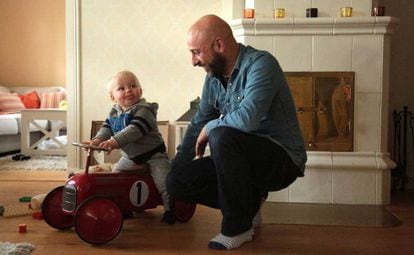“Daddy, why not stay at home if you can?”
It might be considered a beacon of forward thinking when it comes to the work-life balance, but Finland is still discussing how to encourage men to take advantage of their paternity leave

There’s a steady drizzle in Helsinki and the temperature is -9ºC. In bad weather, 41-year-old social worker Sami Seppila keeps the children indoors. But as soon as they can, they get out for some fresh air. This is Finland, and if you’re capable of dressing your child warmly – not an easy task, Sami jokes – getting out is a blessing. When the rain lets up, they make for a muddy park surrounded by long red brick chimneys, functional Scandinavian houses and a Lutheran cathedral. Sami is alone with his two small children, partly because their mother works late, but mostly because he wants it that way.
Sami is one of 4% of fathers who have chosen to take full advantage of their paternity leave. When his eldest child was born four years ago, he took 11 months off to look after him. Now, with his one-year-old, he is planning to take more. “It’s been the best decision of my life,” he booms over the noise of nearby pneumatic drill. Understandable, but that doesn’t make it any less unusual even in this corner of Scandinavia where life-work balance and childcare issues are always a step ahead of the rest of the world.
It seems that among a population of 5.5 million, fathers like Sami are few and far between. “Things take a long time to change,” he says. “The idea that mothers are the ones who stay home is very deeply entrenched in our culture.”
This traditional take on post-natal childcare doesn’t square with Finland’s image as a socially aware country where many women hold positions of responsibility outside the home, and whose secret to success is often said to be its investment in the work-life balance.

“I have learned a lot about myself by staying at home,” Sami says. “Like how to organize myself better – lots of things that can be applied to the workplace. I’ve also learned to appreciate what’s important in life and that doing this is really fun!”
In theory, Finnish fathers have nine weeks of paternity leave paid at 70% of their salary. The first three weeks can coincide with the mother’s maternity leave, but the other six are taken once the mother’s 105 days are finished. There are then a further 158 days that the mother and father can share between them.
While 70% of fathers take the first three weeks, this drops to 50% when it comes to the second six and only 4 to 5% of fathers take any of the last 158 days. The reasons for this vary, but it is generally agreed that tradition is still a big factor and companies don’t always make it easy. There’s also a sense that the system works so well for the mother that it prompts the father to take a back seat.
According to Tanja Auvinen, Director of Equal Opportunities and Employment, “we have studies showing that in male-dominated jobs, attitudes toward paternity leave are antiquated and conservative. The bosses believe that leave is still for mothers.”
One of these bosses is the country’s president, Sauli Niinistö, 69. He is about to have a baby with Jenni Haukio, 40. “The fact we are expecting a child is a private matter and won’t affect official business,” he said in a statement. So will he be taking paternity leave? Former Prime Minister Paavo Lipponen, 76, helped him out by saying that when he was in office this was not an issue, as mothers are chiefly responsible for a child.
Attitudes towards paternity leave are antiquated and conservative, bosses believe that leave is still for mothersTanja Auvinen, Director of Equal Opportunities and Employment
Spanish chef Pablo Capo, 41, lives more than 40km from Helsinki in Kirkkonummi, among pine forests and road signs warning about elk crossing areas. It’s 3 pm and he is inside his wooden chalet, playing with his 15-month-old toddler. Pablo moved to Finland 14 years ago and had his first child soon after. He is now experiencing fatherhood for a second time with a different partner, and making sure to take his paternity leave. “I wanted to nurture a closer bond between us and teach him Spanish,” he explains. “So it’s about getting to know him, but also getting to know myself through the experience.”
His son could go to daycare but, as Pablo points out, as long as he can take care of him, he is better off at home. He casts his mind back to his own childhood. “Of course I have a relationship with my father, but he was always at work and he would get home exhausted with neither the time nor the enthusiasm to tend to our needs. I am close to him, but not as close as I hope to be to my son,” he says, adding that he believes many Finnish fathers put their careers before their children even today.
Still, the Finnish childcare system remains a model for the rest of Europe. In fact, the European Commission has included at least two weeks of paternity leave in its last childcare proposal for member countries. Many don’t even have that. Others, like Spain, already have four weeks. Now Finland is going a step further and suggesting that men should take paternity leave whether they want to or not, with the Conservative Prime Minister Juha Sipila agreeing to push the reform through before the 2019 elections.

Former Education Minister and opposition MP Krista Kiuru speaks passionately about the need for fathers to take advantage of the paternity conditions available to them. “Trusting in freedom and goodwill isn’t enough,” she says in the Finnish capital, where EL PAÍS traveled as part of the Citizens’ Europe program, sponsored by the European Parliament. “Fathers need to be forced to stay at home for at least three months.” Kiuru’s party is proposing a system whereby the mother has three months paid leave, the father has three months paid leave, and finally there is six months that can be shared. But each party has its own take on it – for example, the far right is happy with the law as it is.
In 2013, when their daughter was one, Juhana Tuunanen’s wife went back to work and he took four months away from his job at the Foreign Affairs Ministry to be a stay-at-home dad. He would have taken longer if he hadn’t been posted to the Finnish Embassy in Madrid. “It was probably the best time of my life,” says Juhana who is now back in Helsinki. “It helped me to understand society better. Some of my colleagues from the ministry said, ‘Isn’t it great that fathers do this kind of thing?’ It surprised me a little but that way of thinking is quite common.” Now he is back at work, but he is still able to enjoy his daughter – the importance given to a life-work balance means that at 4.30 pm parents are encouraged to go home.
Finland is going a step further and suggesting that men should take paternity leave whether they want to or not
So why do so few men take full advantage of the paternity leave? According to Johanna Narvi, a researcher at the Institute of Health and Wellbeing, “It’s not so much the fear of losing their jobs or meeting work expectations as the pile of work they will face [when they return]. When an employer doesn’t sort out cover, the father in question has to get on top of his workload before, during or after he comes back.”
Pekka Pekkala, 46, knows all about this mostly because he’s self-employed. He is a communications consultant and has been on paternity leave for two weeks, sharing the care of his two-week-old baby with his partner. His wife walks ahead with the baby stroller while he talks shop on a bench in the Bear Park in Kallio, Once he hangs up, Pekka says his mind is still very much on his work. “I enjoy what I do, but we also need money, my daughter needs it, so I have to work,” he says. “The more I like it, the better it will be for my family and my daughter. But there is no doubt that my family and my daughter are the most important things to me right now.”
The right to return to work
Daycare is different in Finland. Children don’t actually go to school until they are seven years old, making it a practical necessity. But the government covers most of the cost. Daycare centers are not cheap. A private one costs between €1,000 and €1,200 a month, with the parents expected to pay around €330. A state-run center is only slightly cheaper and, in other aspects too, there’s little difference between them. The average salary for people in their 20s with little or no higher education is around €2,000 a month, while highly educated professionals in their 40s earn €4,000 on average. And if the family has no income, daycare may be entirely subsidized.
In the town of Vantaa, 20 km north of Helsinki, the Pikel daycare center specializes in sciences. Little ones between the ages of four and five spend the morning studying the autumn leaves covering the grass in the garden. The teacher gives them a magnifying glass and a lightbox and they get to work.
According to teacher Saara Viteli, every child has a right to a place at a daycare center in Finland so there is never any problem for parents getting back to work at the end of their maternity and paternity leave. It is, however, considered advisable for the child to spend the first two years of life at home. “When the child has had an environment in which all its needs are answered, they feel secure and are more open to new situations,” she explains, adding that they will then allow other adults to teach them to be more independent and take the initiative.
“In Finland, it has been marvelous the way people have been supported,” says Viteli. “The daycare system has to go hand in hand with the needs of the parents, who are the ones who are keeping society afloat by working and paying taxes. In return, they can expect services such as daycare education.”
English version by Heather Galloway.

